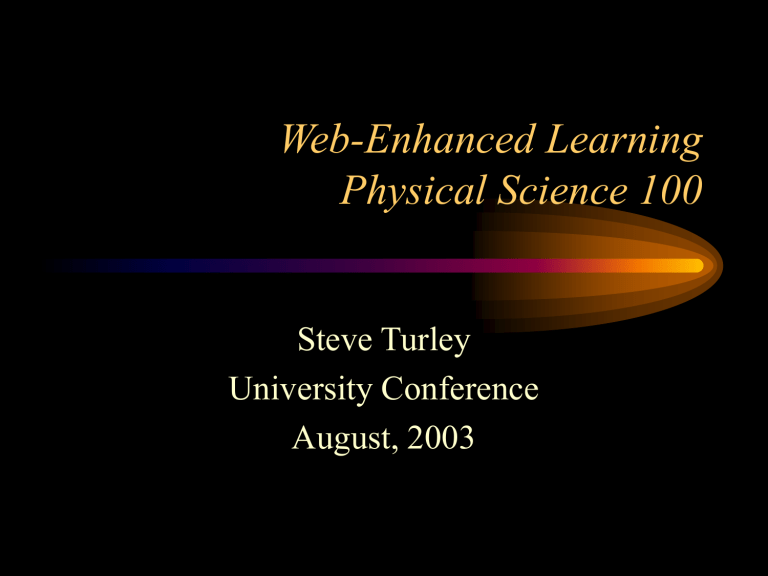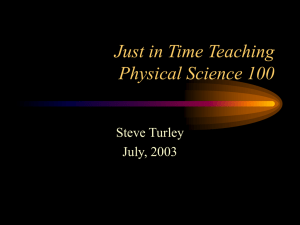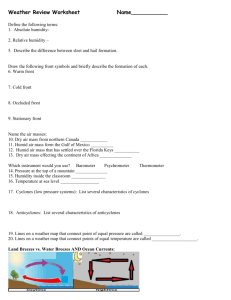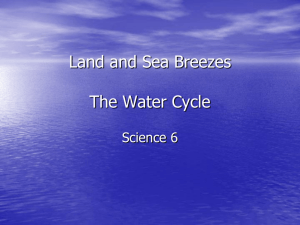Just in Time Teaching Physical Science 100

Web-Enhanced Learning
Physical Science 100
Steve Turley
University Conference
August, 2003
Just in Time Teaching (JiTT)
Learning Objectives
• Engage students in lecture material before class
•
Focus class time on areas where students could use the most help
•
Help students identify areas where they need help
•
Encourage students to come to class with questions they want answered
•
Promote active learning in the classroom
Just in Time Teaching Details
• Students are assigned warm-up exercises using
Blackboard due one hour before class each day
• Results are (mostly) automatically summarized by
Blackboard permitting quick incorporation into that day’s discussion
•
Classroom discussion focuses on their responses in assignments.
Good Questions
•
Thought-provoking applications
•
Avoid recall questions
•
Usually multiple choice
– A few ask why as well
–
Some are short answer
– Matching doesn’t work well
Example Quizzes
•
Reading Question
•
Multiple Choice
•
Multiple Answer
•
Demonstration
•
Short Answer
•
About 95% Completion
Reading Question
•
Question 1 Multiple Choice (1 points)
Question: Did you read Chapter 7:
Conservation Laws?
yes no
•
Only kind of question with credit
Skydiver Question
•
The gravitational potential energy of a sky diver as he leaves the airplane can be calculated from which two factors?
70%
60%
50%
40%
30%
20%
10%
0% weight charge speed ctr of earth ground mass
Energy Transfer Question
•
Which of the following involve radiation energy transfer processes?
80%
70%
60%
50%
40%
30%
20%
10%
0% furnace airflow falling object bonfire light gasoline burning
Oil, Water, and Ball
• A ball is floating in a container half filled with water. Oil is added to the container. The ball is less dense than the water, but more dense than the oil. How does the position of the ball change when the oil is added?
70%
60%
50%
40%
30%
20%
10%
0% up down same
Canyon Question
• Dr. Turley used to live in Malibu and would drive his dune buggy down Malibu Canyon to his research lab on the beach. In the morning, the air over the water would be warmer than the air over land because water cools down more slowly at night than does the land.
– From your knowledge of convection currents would the onshore or offshore breeze help or hinder him as drove his low-powered dune buggy to work each morning?
•
Help (67%)
• Hinder (33%)
– How about in the evening on the way home?
•
Help (47%)
• Hinder (53%)
Canyon Explanations
Convection refers to the circulation of air depending on its density.
In the morning, because the air over the ocean is warmer, its density is less than the cool air over the land, the warm air rises, and cool air form over the land moves in to take its place, creating a breeze blowing toward the ocean (thus helping the dune buggy as Dr.
Turley drives it toward the beach). In the evening, the air over the land has become warmer than the air over the ocean, so the warm air over the land rises, cooler air from the ocean takes its place, and a breeze blows toward the land, helping Dr. Turley drive away from the beach back home.
In the morning, the cooler air over the land would rush out to the sea as the warmer air over the ocean rose. At night, the cooler air over the ocean would rush to the land to replace the warmer air over the land that is rising.
Integration in Class
•
Mixture of learning activities
–
Explanations
–
Answering questions
–
Discussing warm-up activities
–
Demonstrations
•
Warm-up questions often generate other questions
Positive Student Comments
• His class quizes are so great because they help me to read the material and therefore always come to class prepared, and it was so helpful to get the results and talk about them in class that very day.
• The before class quizzes are also helpful but maybe when you put the slides on the course documents on the computer, put the answers to the questions that are asked on there too so that when we refer back to it, we can remember! :)
• I really likes how you had preclass quizzes that required us to read the chapter before hand. That keeps us motivated to stay caught up in our school work instead of falling behind like many of us have in other classes.
• …the pre-class quizzes and in class answers were very helpful…
A Dissenting Opinion
•
I know that our class had to put in more hours in order to do well, compared to other physical science classes. When we are given a grade based on reading a chapter of the book every other day, it forces us students to read. This is a good thing and a bad thing. It is good because it helps us to learn somewhat; however, if you ask any other student in another physical science class if they read the whole book, they would undoubtably respond "no". I will have put in over 40 hours of just reading the book, not counting other 'study time' that was spent going back to review terms and concepts. I read the whole book, not becuase I had to in order to learn, but because I had to in order to get points.
This truthfully took up a lot of my time, and more time than I think was rightfully necessary when compared to other students in other physical science classes. These other kids spent about 1/4 the time kids in my class had to spend on physical science. I believe that things, as far as how much time a student should have to spend on a subject should be relatively eual compared to that of other students in other classes.
Differentiated Assessment
Learning Objectives
•
Students will memorize critical concepts.
•
Students will learn to differentiate test preparation between memorization and higher-level learning objectives.
Implementation
• Generated Blackboard quizzes for each unit which tested each concept I wanted memorized.
• Students could take exam as many times as desired before deadline.
•
Received latest score memorization tests.
•
Exam involving higher level thinking was administered in the Testing Center after master test deadline.
Assessment
•
Grade change due to JiTT or ??
• # of A’s and distribution change significant with p<1%
•
Reduction of
E’s marginally significant
(p=6%)







